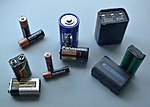The Leclanché cell is a battery invented and patented by the French scientist Georges Leclanché in 1866. The battery contained a conducting solution (electrolyte)...
10 KB (1,265 words) - 14:37, 28 October 2024
Georges Leclanché (9 October 1839 – 14 September 1882) was a French electrical engineer chiefly remembered for his invention of the Leclanché cell, one of...
7 KB (785 words) - 10:32, 3 February 2023
German patent (No. 37,758) on a variant of the (wet) Leclanché cell, which came to be known as the dry cell because it did not have a free liquid electrolyte...
7 KB (831 words) - 16:18, 2 September 2024
lithium–titanate technology, Leclanché manufactures large-format lithium-ion cells. At the end of the second quarter 2012, Leclanché started operations of its...
4 KB (287 words) - 15:45, 11 September 2024
Zinc–carbon battery (redirect from Carbon zinc cell battery)
commercial dry batteries, developed from the technology of the wet Leclanché cell. They made flashlights and other portable devices possible, because...
16 KB (1,751 words) - 07:54, 12 October 2024
History of the battery (section Leclanché cell)
can be reversed by recharging the cell. The lead-acid cell was the first "secondary" cell. In 1866, Georges Leclanché invented a battery that consists...
35 KB (4,485 words) - 22:21, 15 August 2024
Alkaline battery (redirect from Alkaline cell)
metal and manganese dioxide. Compared with zinc–carbon batteries of the Leclanché cell or zinc chloride types, alkaline batteries have a higher energy density...
23 KB (2,574 words) - 00:06, 4 November 2024
by the Leclanché cell in the late 1860s. Sometime during the 1860s, a Frenchman by the name of Callaud invented a variant of the Daniell cell which dispensed...
17 KB (2,127 words) - 09:39, 30 October 2024
Electric battery (redirect from Wet cell)
the dry cell until the development of the gel battery. A common dry cell is the zinc–carbon battery, sometimes called the dry Leclanché cell, with a nominal...
70 KB (7,449 words) - 15:33, 2 November 2024
Primary battery (redirect from Primary cell terminology)
the Leclanché cell and zinc–carbon cell, and nitric acid is used in the Bunsen cell and Grove cell. Attempts have been made to make simple cells self-depolarizing...
11 KB (1,309 words) - 11:25, 9 October 2024








